This simple method for cleaning a stainless steel sink is literally my favorite household cleaning task. I’m not exaggerating. It’s so easy, so simple, and so effective. It doesn’t require any special or harsh detergents and will restore your sink to its original shine in minutes. Sherry tried this method first and we’ve loved it ever since. I’ve even taught our kids how to do it. But honestly, it’s so satisfying that I usually keep it to myself.

We’ve always loved the look and durability of a stainless steel sink. It looks luxurious and pairs beautifully with our stainless steel appliances. But like refrigerators and dishwashers, it’s prone to smudges, fingerprints, and dulling grime. Maybe it’s because we’re constantly washing our dirty hands and dirty dishes. Fortunately, cleaning the stainless steel in your sink is easier and more enjoyable than wiping down the front of your appliance. And did I mention it’s satisfying?
Required materials (only 3!)
The method we use to clean and restore the shine of kitchen sinks requires only 3 ingredients:
Baking soda Dish soap Warm water (from the tap)
This is literally the entire list.
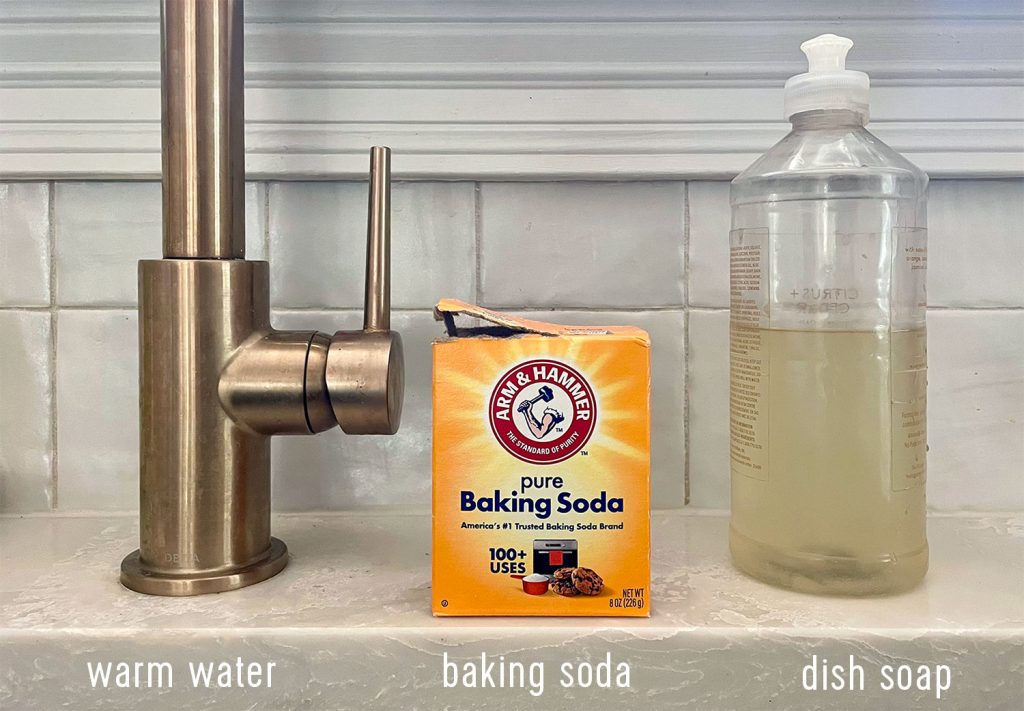

The only supply you may not already have near you is baking soda. You can buy a small box for less than $2 at any grocery store. Other methods include supplies like white vinegar, lemon juice, rubber gloves, and microfiber cloths. These can be used, but we don’t usually find them necessary. Instead, keeping your list of supplies short and concise increases your chances of getting the job done.
6 Steps to Clean a Stainless Steel Sink
If you’re like us, you’ll find the steps easy, fun, and oddly satisfying. It’s like playing with clay or kinetic sand, but at the end you get a shiny tub as a reward. Watch the process in this video or follow the full written instructions below.
Empty the sink, sprinkle with baking soda, add some dish soap, scrub, rinse, dry or wipe.
Note: You can also watch this video on YouTube.
Step 1: Empty the basin.


First, clear the sink of any dishes or debris. This means: Load the dishwasher, remove any pots or pans, and rinse away any food residue. You should also remove any sink trays, sponge caddies, or other obstructions. This will give you easy access to the entire surface of the sink.
Step 2: Sprinkle baking soda.
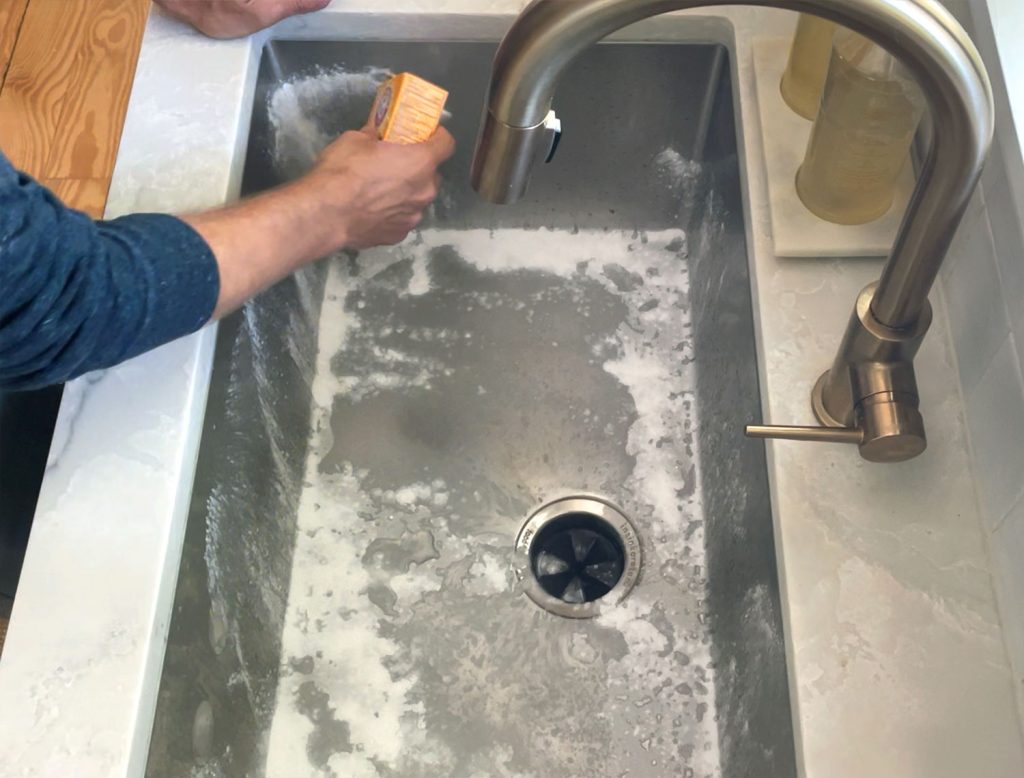

Next, sprinkle baking soda over all surfaces of the wet sink. It doesn’t need to be completely covered, but we suggest using a generous amount of baking soda. We don’t measure anything – just shake it straight from the can and start sprinkling it lightly all over the sink. You can always add more as you go.
Step 3: Add some dish soap.
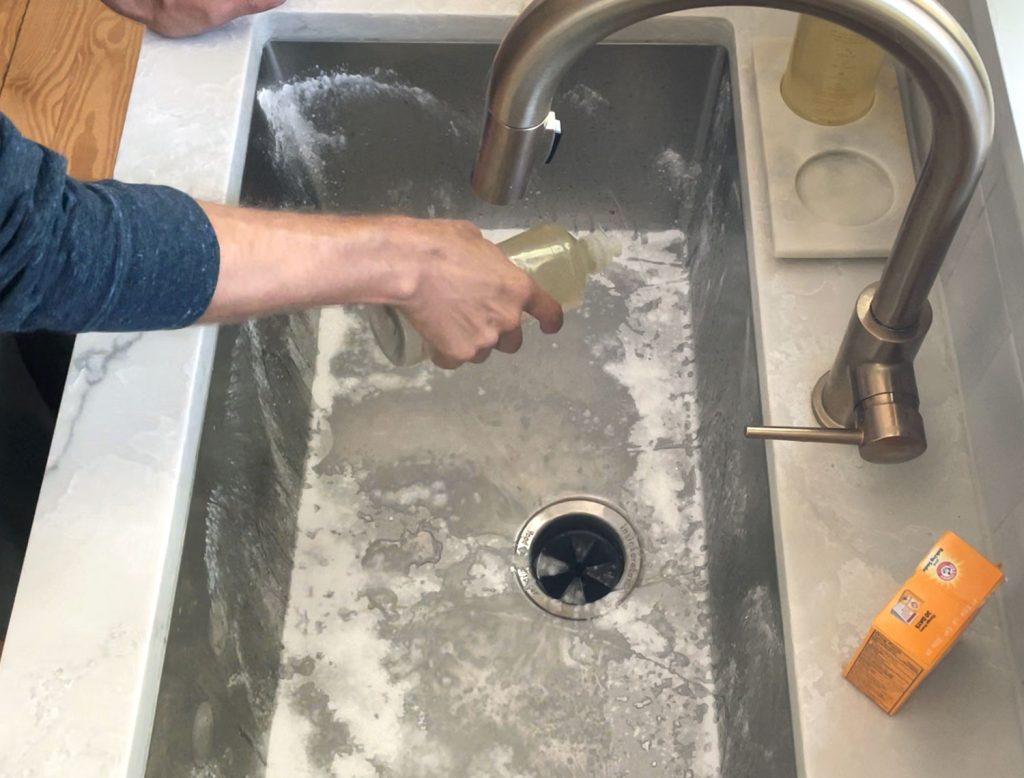

Next, sprinkle a little liquid dish soap on the baking soda. This drop of soap will help clean, disinfect, and deodorize the sink. Lemon juice and/or essential oils can also be used to add a natural scent. A light sprinkle around the sink is enough. Again, more can be added as needed.
Step 4: Scrub, scrub, scrub!
Now it’s time for the fun part! The baking soda and soap will form a rough, scrub-like paste (sounds gross, but it’s not) that you can scrub around your sink. You may need to add a little water to get it to a consistency that’s easy to scrub with. Just don’t add too much and rinse it all down the drain.


You can wear gloves or use a microfiber cloth for this part, but we prefer to clean with our bare fingertips. This makes it easier to feel which areas have been cleaned smoothly, and which areas may need a little extra care. It’s a bit messy this way, but that’s also what makes it so satisfying.
Step 5: Rinse the sink.
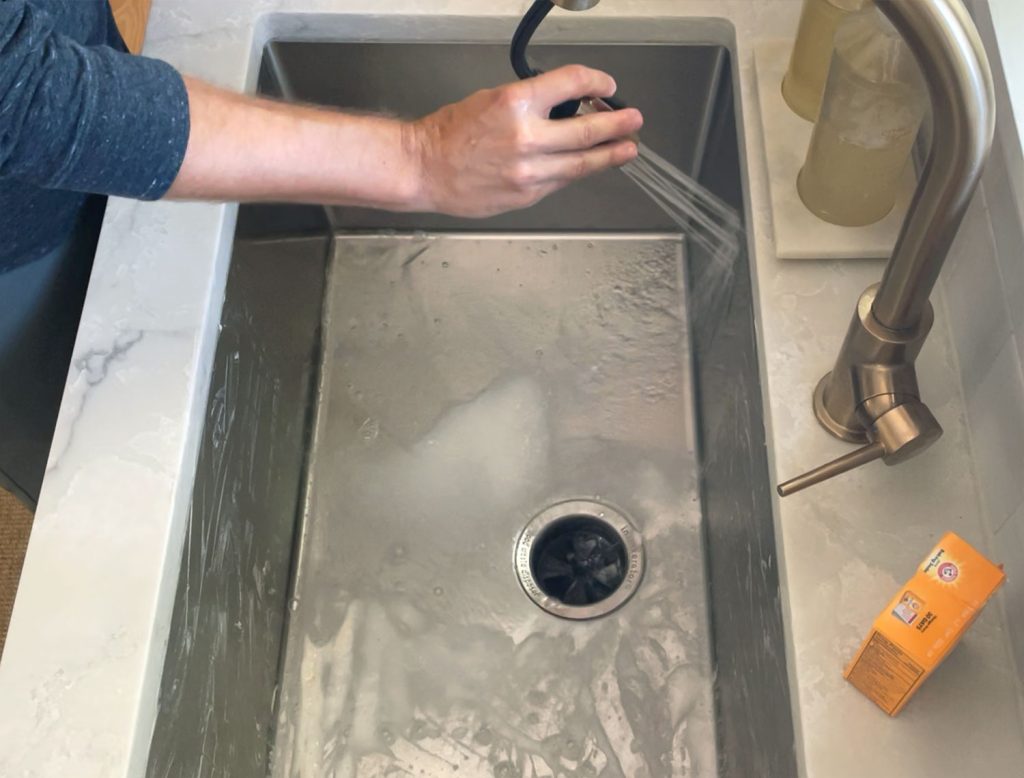

Once you’ve cleaned the entire sink—don’t neglect the corners, edges, and around the drain!—rinse everything off with some warm water. If you notice any spots that didn’t get cleaned, simply sprinkle on more baking soda and scrub the area again. It’s easy, so don’t worry if you don’t get it 100% clean the first time.
Step 6 (Optional): Dry or polish.


Finally, you can use a paper towel or clean cloth to wipe the sink dry. This final “polishing” step really gets it shiny. It will also prevent any water spots or streaks from forming on the freshly rinsed steel. Feel free to skip this step since the faucet will be used again soon, getting the entire sink wet again – but if you want a satisfying “after” result, just give it a try.
When to clean a stainless steel sink
The above method is something we do as needed, usually once every week or two. For everyday cleaning, we typically use a faucet sprayer and a sponge to rinse away any obvious residue or food particles. This prevents messes, odors, and rust stains, but it doesn’t bring back the new shine that baking soda provides.
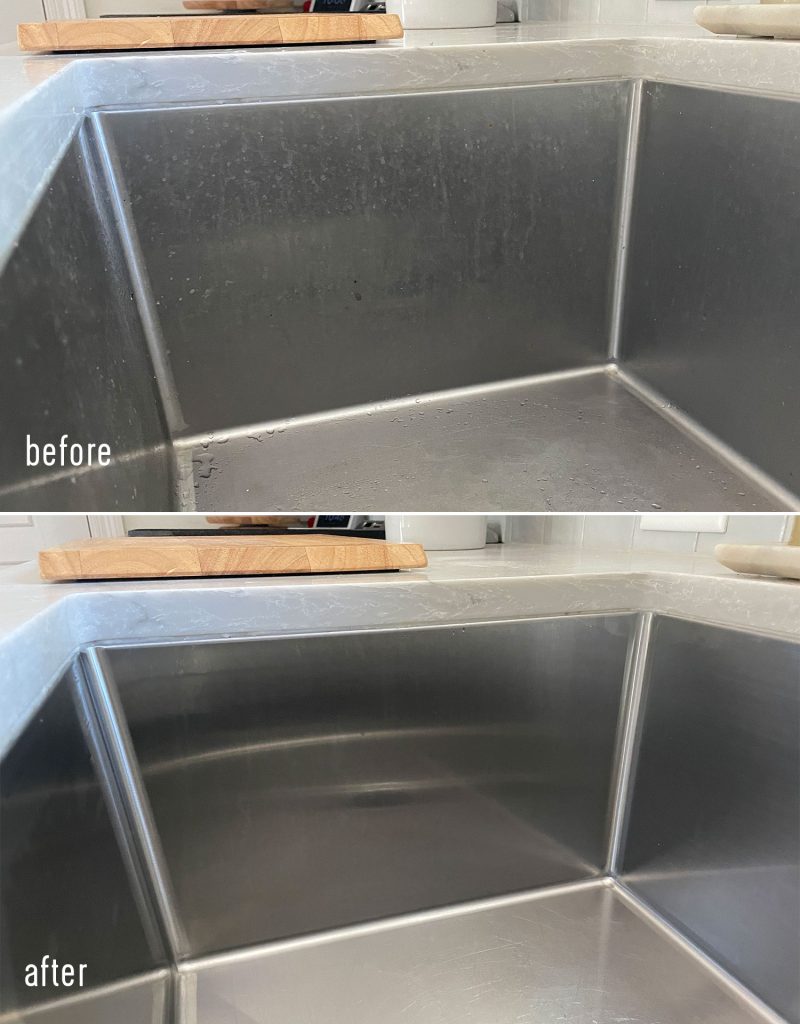

Would you believe that the photo above of our sink was taken after over four years of heavy use! For a deeper clean or more stubborn stains, you can use the method above but substitute the white vinegar for dish soap. We’ve heard that the reaction between vinegar and baking soda can help remove stubborn stains. We’ve never had to go that route, as we just use the steps we detailed above. You can also try commercial stainless steel cleaners like Bar Keepers Friend as another line of defense against extra stubborn stains.
What to avoid
As you’ll learn from this method, it doesn’t take much to keep your stainless steel sink looking its best. But stainless steel can be susceptible to rust and hard water stains, so you may be tempted to try more aggressive techniques. Just keep the following limitations in mind:
Don’t use steel wool or other hard brushes, which can leave scratches. Avoid harsh chemicals like bleach or other cleaners not designed for stainless steel. Don’t leave metal utensils or tools on for long periods of time, which can scratch them or encourage rust. Standing, stagnant water can cause stains or corrosion, so make sure the drain is working properly and the sink is level.
These practices, combined with regular cleaning, will help you maintain your stainless steel sink for a long time.
Why clean your stainless steel sink?
In addition to improving the appearance of your tank, performing regular deep cleanings of your tank has other benefits:
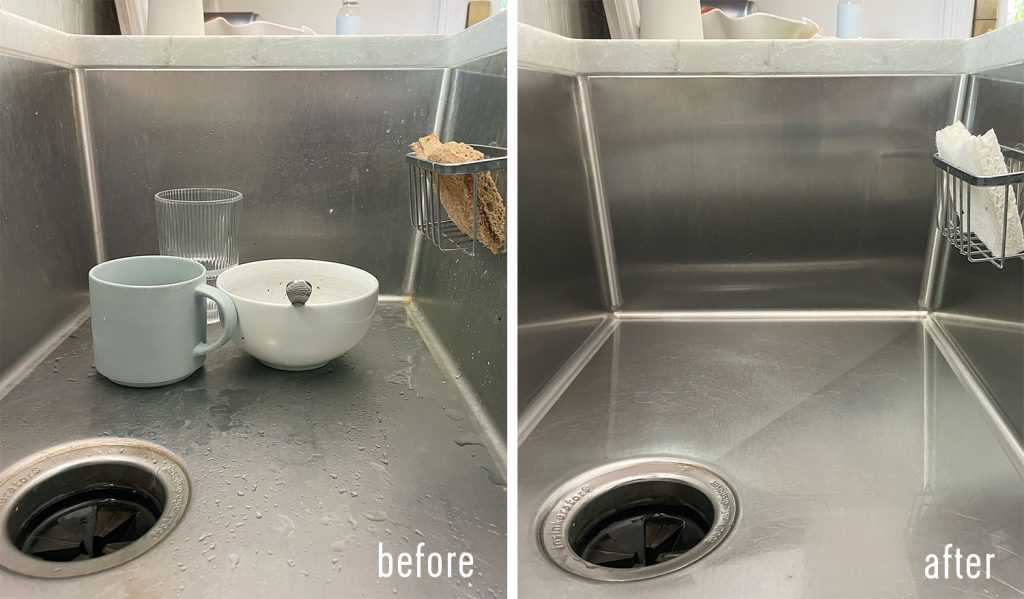

Reduces odor
Not only are food stains unsightly, they can also cause unpleasant odors in your kitchen. Not only does this baking soda method remove those stains, but using dish soap (or lemon juice) adds a fresh scent to your sink.
Improves hygiene
Baking soda, white vinegar, lemon juice, and dish soap all have antibacterial properties that help keep your sink healthier, including fighting bacteria like E. coli and salmonella. This will help make your sink a healthier place to rinse/prepare food or wash dishes.
Prevents stains
Regular cleaning with baking soda will help prevent permanent stains, especially in areas where things like sponge boxes or sink shelves may accumulate that you don’t see on a daily basis.

